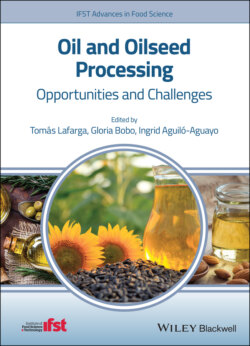Читать книгу Oil and Oilseed Processing - Ingrid Aguilo-Aguayo - Страница 21
1.2.7 Palm and Palm Kernel Oil
ОглавлениеThe oil palm fruit, which is obtained from the palm tree (Elaeis guineensis L.), is a drupe formed in tight bunches. Palm fruit is mainly used for the extraction of palm oil driven by a lower price, and the fact that one hectare of oil palm plantation can produce up to 10 more times oil than other leading oilseed crops (Mba et al. 2015). Palm oil can be divided into crude palm oil, obtained from the fruits mesocarp, and palm kernel oil. Both are key important in world trade. Indeed, palm oil was the fourth most produced commodity within the “processed crops” classification of FAOSTAT, surpassed only by beer of barley, sugar, and molasses. Palm oil production has boomed over the last decades caused by an increasing use as frying oil, as an ingredient in foods and other products such as detergents, and biodiesel production (Pirker et al. 2016). As shown in Figure 1.2, total world production of palm oil increased from 45.78 Mt in the year 2000 to 57.33 Mt in 2014. In 2019, the total world production of palm oil has been calculated as 70.90 Mt, representing a 16.16% annual increase during the last decade.
Malaysia and Indonesia have been the center of this impressive increase. As an example, planted areas increased from 3.37 and 2.01 Mha in 2000 to 5.11 and 9.28 Mha in 2017, which represent an averaged 8.90 and 27.09% annual increase during the period 2000–2017 in Malaysia and Indonesia, respectively. The USDA recently forecasted the Indonesian oil palm harvested area for 2018/2019 as 11.3 Mha. In 2016, Vijay et al. (2016) assessed the impact of oil palm on deforestation and biodiversity loss and reported that 45% of sampled oil palm plantations evaluated in Southern Asia came from areas that were forests in 1989 (less than three decades). Similar conclusions were obtained by Henders et al. (2015), who observed that over 50% of Malaysian and Indonesian oil palm plantations in 2005 were on land that was forest in the 1990s. This has led not only to obvious negative environmental issues, but also to closer scrutiny from consumers. However, as global demand for food increases and land availability in those countries becomes scarcer, governments of developing and emerging countries such as Brazil, Peru, and some African countries are increasingly promoting palm tree cultivation (Pirker et al. 2016). Nowadays, the palm tree is cultivated in several countries with adequate temperature, sunlight, and rainfall (Figure 1.1). However, major palm oil producers continue to be Indonesia, Malaysia, and Thailand with an annual productions in 2017 of approximately 29.27, 19.67, and 1.85 Mt. As shown in Figure 1.3, Malaysia and Indonesia are also the largest palm oil exporters with approximately 22.76 and 13.81 Mt exported during 2017.
Figure 1.2 Area harvested and production of palm, rapeseed, soybean, and sunflower seed oil.
Source: Data accessed on April 8, 2019 from FAOSTAT, available at http://www.fao.org/faostat.
Major palm oil importers in 2017 were India, China, and Pakistan with 8.26, 4.48, and 2.60 Mt respectively.
Figure 1.3 Palm oil: Production and trade. Abbreviation: PNG, Papua New Guinea.
Source: Data accessed on April 8, 2019 from FAOSTAT, available at http://www.fao.org/faostat.
